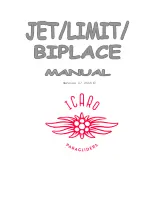
Page 5 of 13 pages
2. Items included in the Hughes H-1 package:
Preformed fixed main landing gear
wires; pushrods with pre-formed Z-
bends; wheels; pre-trimmed
cockpit canopy; empennage
fairings; vertical and horizontal
stabilizers (with pre-hinged
elevator); wing with pre-hinged
ailerons and landing gear mounts
(prepared for either the supplied
scale, fixed landing gear, or easy
installation of the optionally
available retractable landing gear);
“Max Cowling” fiberglass cowl
assembly; motor mount pylon; and
fuselage with preinstalled wing
fairings and wing-bolt blind-nuts.
Items also included but not shown
in this photo: Magnetic battery
hatch;
pull/pull rudder and tail wheel control assembly; tail wheel and aileron linkages; all required control horns; wheel
collars; fixed-landing-gear retainers; preassembled spring-loaded steerable tail wheel; wooden empennage/fairing
reinforcements; self-threading screws (except those supplied with motor and servos); and this illustrated
instruction manual.
HUGHES H-1 ASSEMBLY INSTRUCTIONS
Step 1: Power system.
1.
Solder connectors to the motor’s and the ESC’s matching sets of 3 hi-current wires, and solder a polarized
connector to the ESC’s and battery’s red and black leads. If your connectors are not already fully insulated, cover
exposed metal surfaces at each connection with heat-shrink tubing to prevent short circuits. (At this time leave
the motor’s 3 wires NOT connected to the ESC’s 3 wires, do NOT connect the ESC to the battery, and do NOT
attach a propeller to the motor.) Set aside the ESC and the battery.
2.
Using the predrilled holes in the motor-mount pylon and 4 screws provided by the motor’s manufacturer, attach
the motor to the front, outside of the motor-mount pylon. Connect the
motor’s 3 wires to the ESC’s 3 wires, plug the ESC’s 3-wire
BEC/throttle connector into the receiver’s throttle channel, connect
your aileron, elevator and rudder servos to the receiver, and check the
motor’s rotation (and center your servos) as follows …
a. If you are using a computer radio, ensure the transmitter’s “end
point adjustments” are set to their normal, full-range settings. Set
the transmitter’s throttle and throttle trim controls to minimum and
center the transmitter’s aileron, elevator and rudder trim controls.
With NO PROPELLER on the motor, switch ON the transmitter.
b. Connect the ESC to the battery and listen for a series of initialization
sounds from the ESC, and the aileron, elevator and rudder servos should travel to their centered positions. Then,
raise the transmitter’s throttle stick approx. halfway up, and the motor should power-up in the clockwise
direction as viewed from the rear of the airplane. If so, proceed to step 3.
c. If the motor powered-up in the counterclockwise (wrong) direction as viewed from the rear of the airplane,
return the throttle control to minimum, disconnect the ESC from the battery, swap either 2 of the 3 ESC to
motor wires, and repeat “a” and “b” above to ensure the motor rotates in the correct direction.































